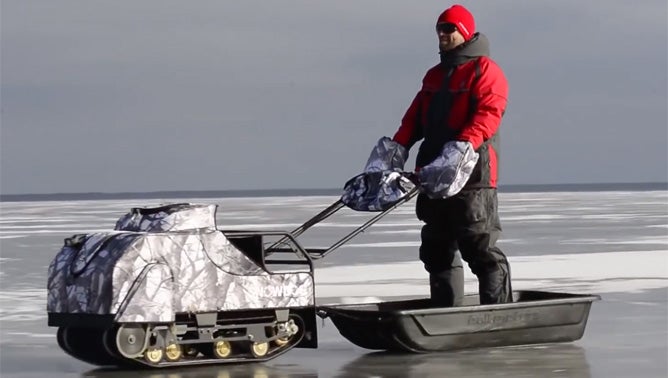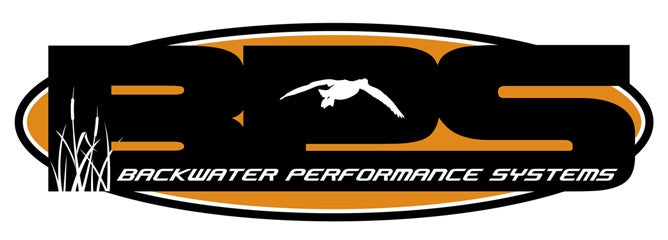Introduced in the U.S. in early 2018, SnowDog utility task machines (UTM’s) have been brought to western marketplaces through SnowDog LLC, after decades of use in the rough and very wintery Russian territories. Produced by Baltmotors in Kaliningrad, Russia on the Baltic Sea, the stateside versions are designed to specifications of SnowDog LLC, who also imports them and partners with Power Distributors through a network of 70+ dealers. The result has been a rapid expansion of these unique machines. For those of us in Canada and America, they bring a truly new and interesting off-road solution.
What makes the SnowDog UTM so different? First of all, there’s a lot to the machine that is neither new nor unique. For instance, they rely upon some of the same proven strategies as snowmobiles: articulating track, and a continuously variable transmission (CVT). What distinguishes it is not the components but the way they are combined, and the final package. A SnowDog UTM is much smaller and lighter than a snowmobile, pulls both operator and payload (up to 1,100 pounds), and only requires a 13.5hp Briggs & Stratton engine.
Like a tracked mini-tractor, the machine is pure utility (hence the UTM categorization). Capable on dirt, grass, marshy areas, sand or snow, and equipped with a micro-pintle hitch, it’s also at home on jobs and landscapes that would make a snowmobile cringe. The SnowDog website and user YouTube videos capture that versatility, showing all manner of gear being hauled, including trains of cargo sleds.
As a relatively inexperienced snowmobile user (~10yrs on four machines), I understood the limitations of doing work with the most iconic winter machines. In the process, I’ve dug out 500 to 700-pound Ski-Doo’s more than I care to remember. And like most riders, I’ve learned that technique, terrain and snow conditions are everything when it comes to these beasts. So, the diminutive SnowDog, which weighs up to 340 pounds, made me scratch my head. How do you even steer it, I wondered.
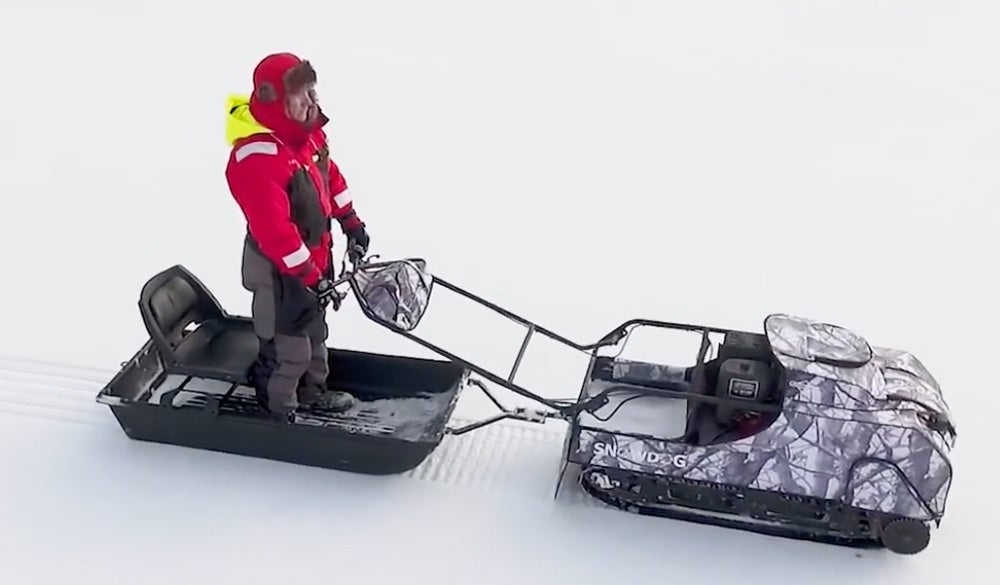
Table of contents
Design of the Dog
If you’ve pushed a self-propelled lawn mower then you’ve already experienced the physics of the machine. The operator is pulled from behind, riding aboard one of several devices offered by SnowDog or that can connect to the machine’s hitch. It’s turned by counter-steering, the user pushing the long handlebar down and laterally. The more you push down the less the SnowDog’s track makes contact with the ground, and the easier it slides/pivots in the desired direction. As someone who paid for college by mowing lawns, I found this action to be fairly easy to grasp. Gaining fluidity and skill at navigating rugged terrain took more time.
You may be wondering why anyone needs a SnowDog. If you’re like most off-roaders, the need often leads to the machine. SnowDog markets to low-speed, utilitarian winter travel. Top examples are ice fishing, farm/woodlot work, and hunters. Those all make sense, and SnowDog offers accessories to support each of them (e.g., cargo trailer or sport trailer,). But what led us to purchase a SnowDog was much different.
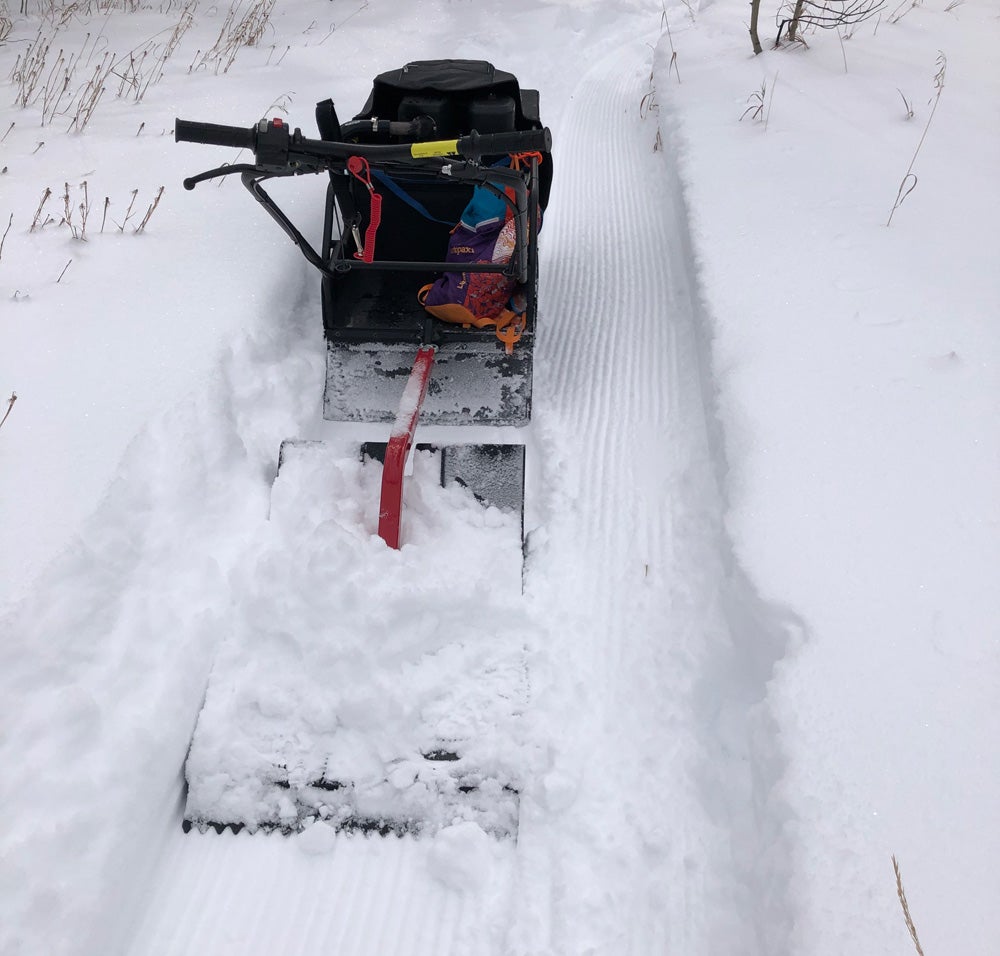
Utah is a mecca for mountain biking, and the advent of fat bikes meant our pedaling habit could extend year-round. Unfortunately, snowbiking doesn’t work when the fluff is deeper than 2-3”. It’s simply too much work as the oversized tires, which range up to 5” wide” create forward resistance in proportion to their ability to float. The answer, we’ve learned here in the Northern Wasatch Mountains, is to “groom” trails to ride.
If that sounds like what you’re use to at a ski slope then you get the problem this presents. Enormous snowcats aren’t much good for grooming narrow, winding trails…and they carry five- to six-figure price tags. Neither are the heavy, two-speed utility snowmobiles that cross-country ski trails are groomed with. What we needed was a maneuverable machine to pull a small grooming device.
In 2018, when we learned about the SnowDog it was obvious this was the tool we needed. For years our trails were packed down by running vintage Yamaha BW200 motorcycles. These weird and wonderful bikes have their place, but breaking trail through deep snow was not it. SnowDog had already seen these niche needs, offering both a cross-country “Ski Trail Groomer” and a “Singletrack Groomer.”
By the time the first snows had blanketed Northern Utah for the 2018-19 season, we had picked our first machine from Backwater Performance in Salt Lake City. A SnowDog Standard (B13ME) model without reverse (an option), the machine was chosen over the Compact model for its greater floatation and larger rear cargo area. Nonetheless, it can still fit inside a Subaru Outback, and thus most SUVs. For easy of transport, the SnowDog’s long handle flips forward and nestles atop the body.
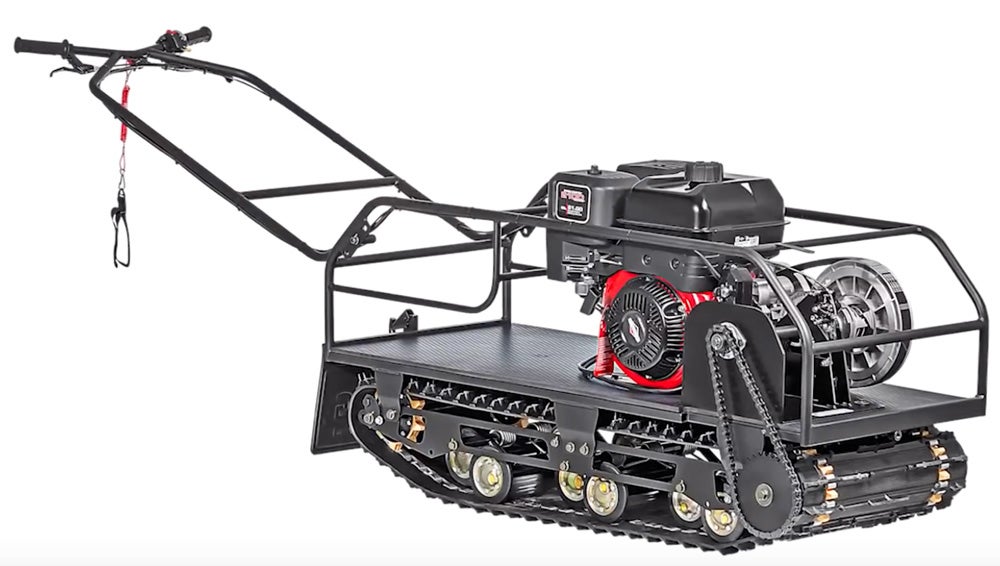
When it comes to thinking through a host of user needs, SnowDog deserves credit. The machine comes fully equipped with an LED headlight, 12v accessory plug, and large cargo space that perfectly fits an eight-gallon Action Packer box. Similarly, its accessory line gives you options from handlebar mitts that attach to the bars, to a cargo bag and storage cover.
Operating the SnowDog
A SnowDog handles differently from other machines. Familiar yet unique, their behavior is related to 1) the operator’s rearward position, 2) to having no steering mechanism per se, and 3) to the configuration of the machine itself. Relatively long (58”) but narrow (24” body atop a 20” wide track) and tall (30”), the machine’s handling is mild-mannered. It can be reliably turned 180 degrees on tight switchbacks with even the non-reverse Standard model.
Operator controls are conveniently placed and logical (e.g., right-hand throttle). Large bike levers make user adjustments for cable stretch a simple task. Throttle response is prompt but without drama as the CVT engages. The LED headlight has an On/Off switch, though gloved hands can accidentally hit it during ignition or when turning off the engine, as the start “trigger” and kill switch both reside immediately adjacent.
Speaking of killing the motor, SnowDog equips each machine with an emergency kill switch. Tethered to the operator’s wrist or waist with a flexible cord, the switch (for those who choose to use it) works perfectly. In fact, the only times we have ever experienced the unit not starting within a few seconds of hitting the ignition was when the kill switch had been pulled before it was last parked. Thankfully, the machine stops quickly after the throttle is released, so many owners may not use this safety feature.
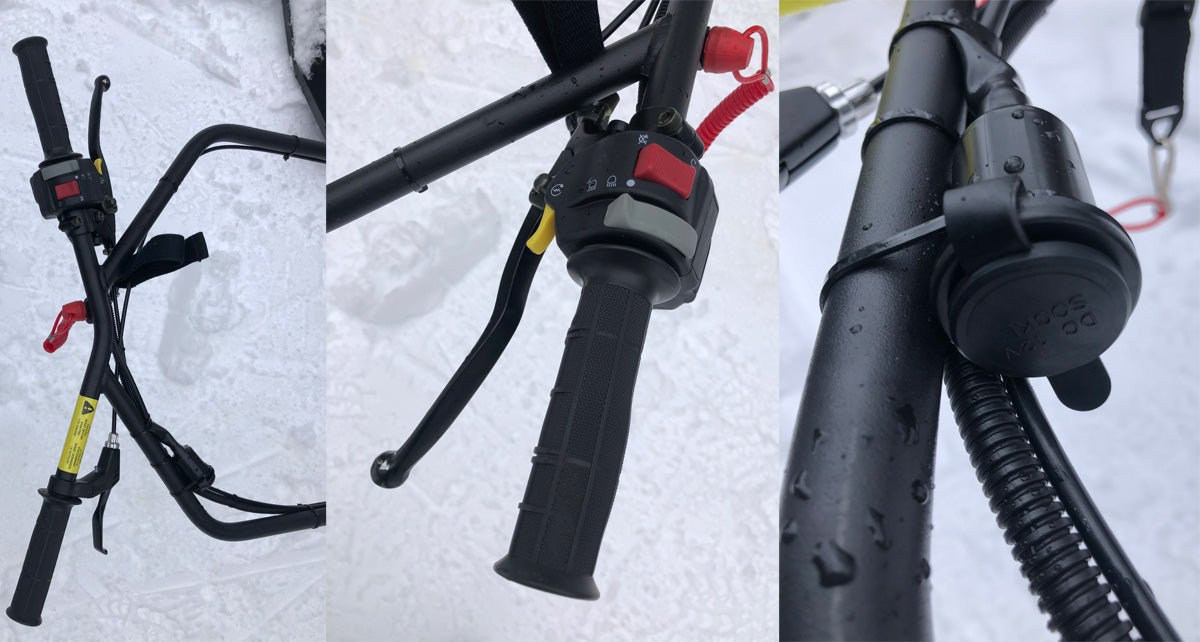
Braking is mellow but effective, though engine braking alone will ease the SnowDog to a stop. Engine idle does not let the machine continue moving, as the CVT disengages for safety just like a snowmobile. Conversely, when under throttle the machine moves along at a good clip. GPS shows we tend to average 4-5 mph when grooming, though the machine is rated to 20 mph. This may be optimistic in terms of speeds you are likely to experience, but 15 mph on mixed but smooth surfaces seems very realistic.
Fuel efficiency is a claimed strength of the SnowDog, and that is confirmed by our usage. With a claimed average usage of 0.5 gallons per hour, and ample on board room for a Rotopax or other fuel container, users can expect many hours of use from $10 in fuel. Not surprisingly, Briggs & Stratton calls for not running E85 gasoline. In reality, we prefer to only use ethanol-free fuel.
Despite that efficiency, SnowDog rates all models at a 1,100lb pulling capacity on snow. We have yet to test this pull limit, but it seems very reasonable assuming a plastic sled on relatively compact snow. By comparison, trail grooming is more like towing a heavy comb down the trail; it acts like a grab anchor with an adult operator aboard. Still, other than on steep slopes and knee deep snow, it pulls the rig along very well, whether at a walking pace or a fast run.
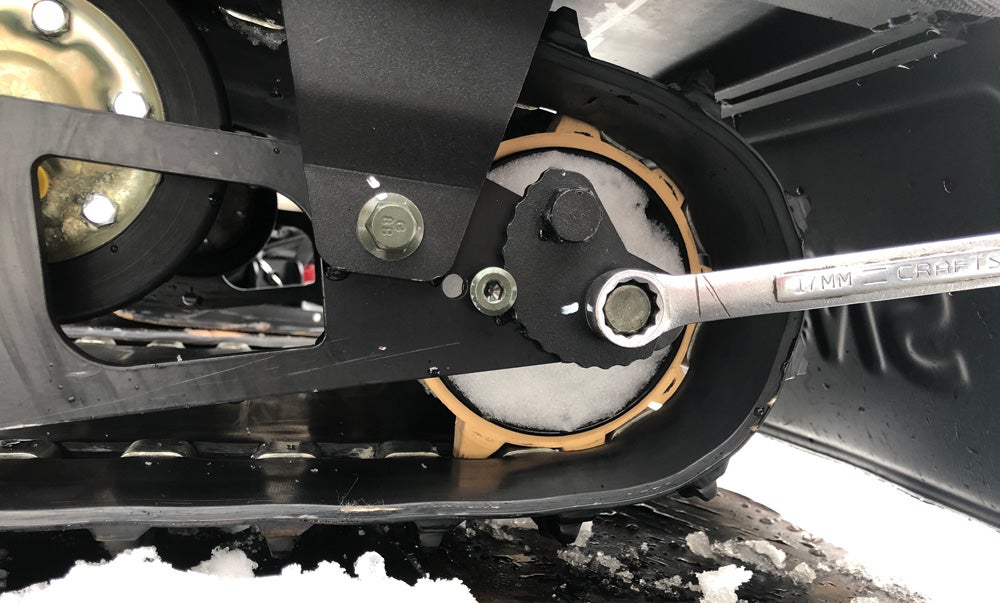
Each SnowDog is designed with adjustability so that the handlebars can be repositioned to match the user’s stature, whether they are standing or seated. Three adjustment holes allow you to place the bars at different heights. Once the handlebars are adjusted, the next adjustment is the length of the groomer or trailer bar/tongue. These settings also alter the position of the operator relative to the handlebars. A simple bolt secures the sleeved hitch pieces together.
As simple as the SnowDog is, how challenging it is to operate depends largely on the terrain. In untracked snow, especially of the fluffy sort, the machine can be readily guided about. By leveraging the bars, the track readily responds to steadily pull through the snow. How much snow? We have routinely plowed through 12” or more of freshly fallen snow atop older, more firm base layers. If traction is lost, the SnowDog can be easily tipped to the side and the snow beneath compacted to gain traction. Getting one stuck isn’t easy.
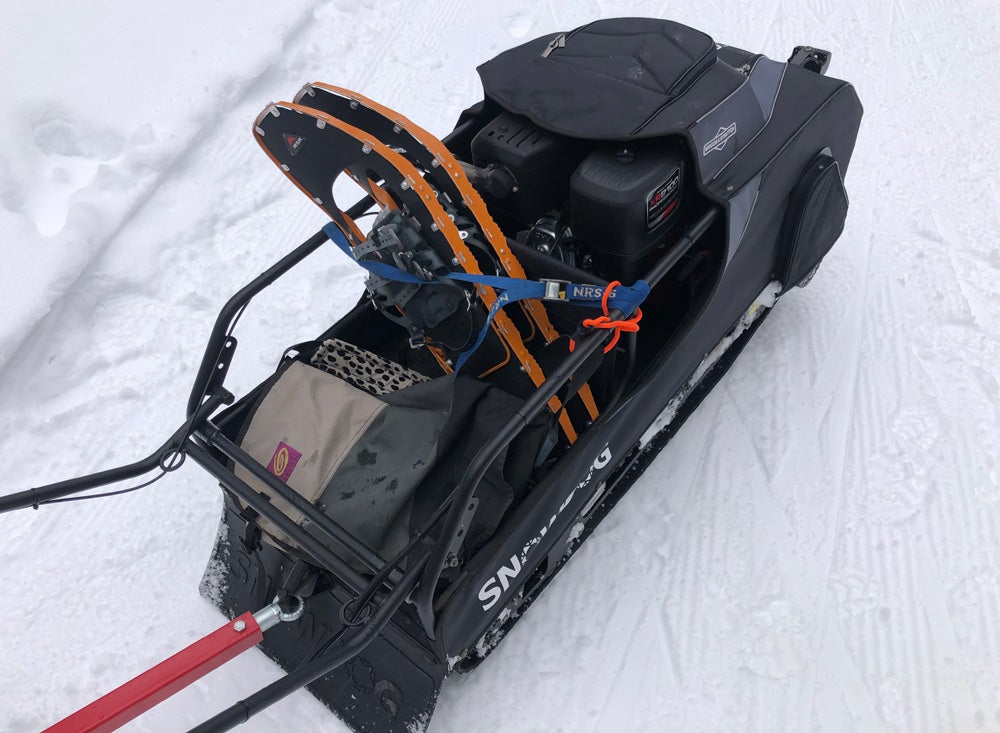
That ease of tipping can also present a challenge. The SnowDog’s narrow stance, coupled with the fuel and motor perched relatively high, mean that it can lean too far if operated on cross slopes beyond 15-20 degrees. The same is true if the snow surface is very uneven. The best example of this is when following the compacted trail of snowshoers in deeper snow that isn’t fluffy. If the track must run on both the compacted trail and surrounding snow that is more than ~6” higher, the SnowDog is challenging to keep pointed down trail. It wants to bank away from the higher snow surface. In a narrow trail of footprints this can result in it carving back and forth.
In most conditions this is not a problem. Nonetheless, if you will frequently or predominantly be traveling in very uneven snow/terrain, then keep in mind that it takes extra operator attention, as well as more body English. In untracked snow that isn’t deep and heavy, this leaning isn’t an issue. Likewise, on wider trails, or those without steep side “walls” of untracked snow, the operator won’t face any problems with excess leaning.
But what if the SnowDog does tip over? On more than one occasion – some accidental, others intentional – I have laid it over. In snow a tip over is never fully 90 degrees. Usually it reaches about 45 degrees, and is held there by the snow. If that happens, one or two good tugs will right it. The only challenge in doing so is that the SnowDog cover prevents any access to the frame forward of the mid-point. This isn’t a big deal, but has made us want an attachment point on either side at the front to affix a simple hand loop/handle. In situations when you do fully lay the machine on its side on flat ground, one person can tip it upright. The exposed frame is sufficient to gain a handhold, though your foot may need to create a fulcrum against the track.
Much like a musher on a dogsled, the SnowDog also responds very well to use of your feet to either push with one leg, or to run a few steps. This technique is really only needed on steep inclines or when getting underway in loose snow or with a heavy load. However, it illustrates, along with the technique for turning, that to operate the SnowDog effectively you need actively move and adjust your body. It’s a lively dance of human and machine, no different from skilled operation of a motorcycle or snowmobile. It is not a passive experience, like driving a tractor or riding lawnmower.
For those packing or grooming winding trails this dynamic presents a unique opportunity. By leaning the machine into a turn, and shifting your weight on the groomer, it is possible to build up banked corners. For fat bike riding, this is the wintertime version of flowy mountain bike trails.
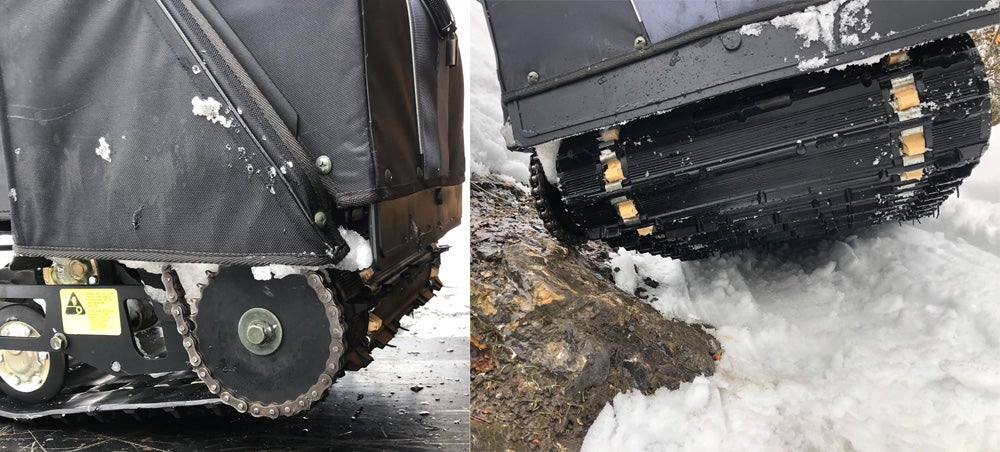
This technique offers a glimpse into the subtleties of operating a SnowDog in varied trail conditions, and for differing purposes. For instance, in early season, when trail hazards (e.g., rocks, stumps) may not be fully buried by snow, we have found it wise to protect the exposed drive sprocket. Even with the optional Drive Sprocket Guard installed (a wise investment), it is best to use the left side of the SnowDog for widening trail. With its overall rugged design, the exposed, low to the ground drive sprocket (though heavy duty) may be the must vulnerable component on these machines.
For those who plan to travel after dark, the SnowDog’s LED headlight has you covered. More often than not, we use the machine for grooming trails during the night, typically when temperatures are in the teens, and frequently as snow falls. The little LED casts ample light for forward travel, offering the pattern and hues that make for an effective cone of illumination with good contrast and color. For anything rearward of the motor the headlamp offers, at best, some ambient light reflected off of snow. A headlamp is thus a smart companion to carry along. Additional LED headlights, however, can be purchased from a local SnowDog dealer.
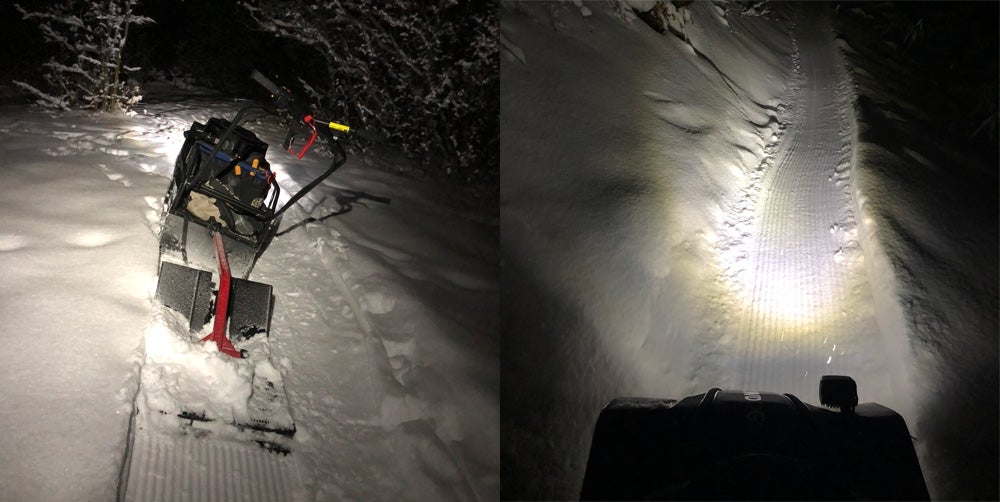
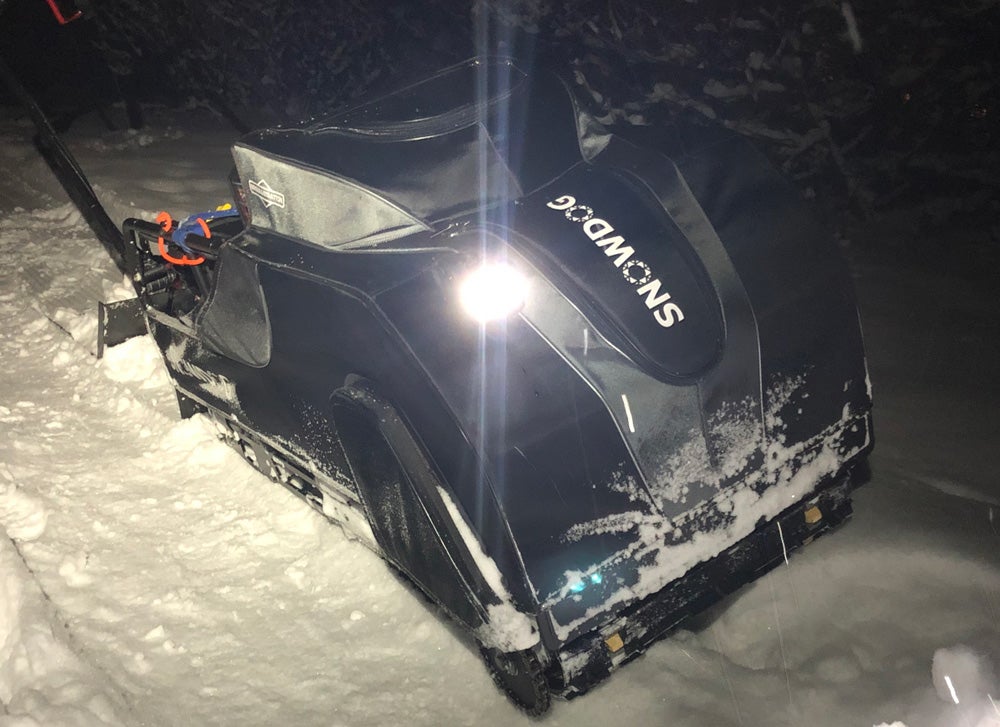
Refining the Dog
No machine is perfect from the factory. That holds true for the SnowDog. And while the company’s line of accessories cover many needs, a few changes were needed for our volunteers to comfortably operate the machine. The easiest of those was elevating the handlebars. The three factory adjustment holes all place the bars a bit too low for operators who are standing (Note: for seated operators the options seem fine). Operators complained of shoulder and back aches after grooming our 7mi trail system. Fortunately, the fix is fairly simple, and only requires a set of plastic pipe shims (1/4-3/8” thick) being used to help elevate the bar angle.
Similarly, for the Singletrack Groomer, the factory positioning was somewhat too far rearward due to the sleeved hitch holes. But this, too, is easily resolved. By drilling a more forward adjustment hole the through-bolt allows the tongue to be shortened, and a more comfortable, upright stance results. This change, along with the bar adjustment, made the handlebar ergonomics comfortable for sessions up to two hours.
The next tweak relates to the engine and the elevation you are operating it at. If you’ve spent any time behind a lawn mower you know about breathing Briggs & Stratton exhaust. The SnowDog is no different. Venting directy off the back of the engine, the exhaust port is oriented toward the operator. SnowDog reminds users that the elevation you will operate the machine at can affect the extent to which fumes are experienced. If necessary, rejetting the carb may be necessary. This will be more relevant if you operate the machine at slow speeds (<5mph).
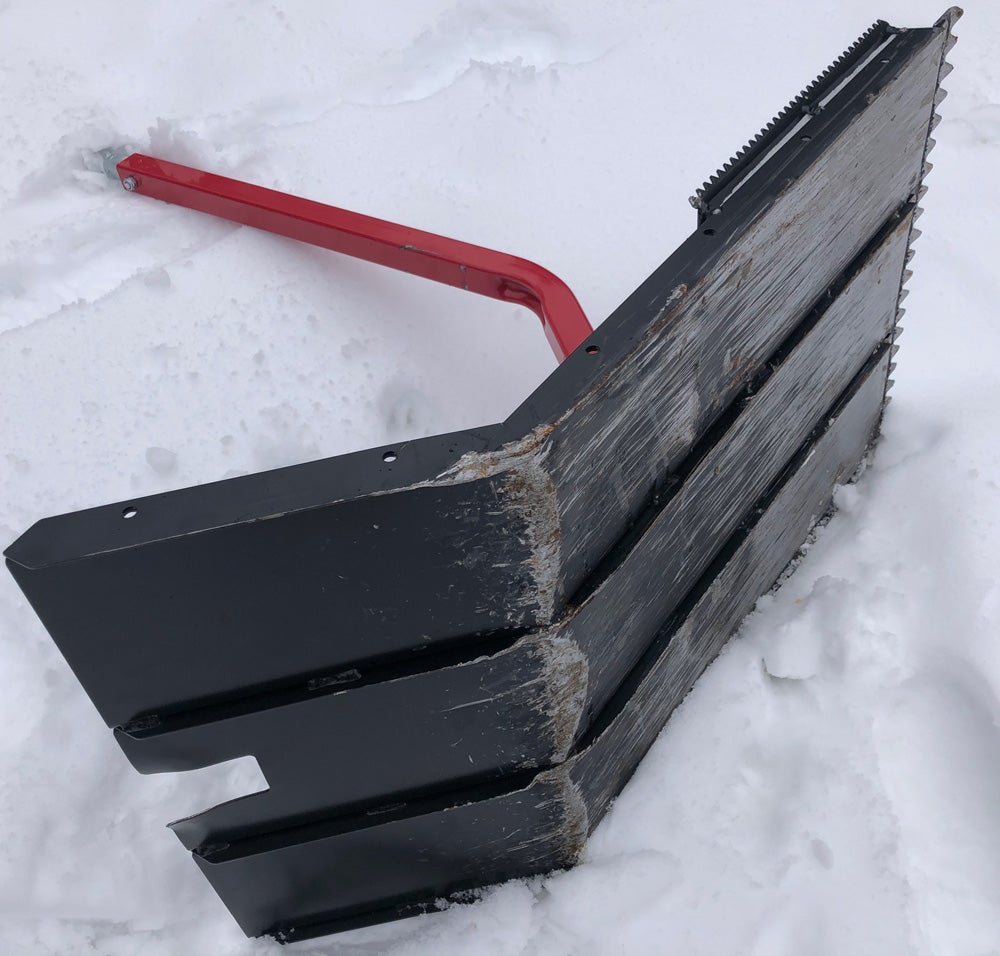
The final adjustment we made was on the Singletrack Groomer. Creating a smooth, strong surface from snow relies upon a mix of spreading and compacting snow. The SnowDog groomer does a very good job of this. It fills in footprints and divots, and shaves off the high points. The challenges comes with its rear tines. The metal tines are meant to produce a “corduroy” pattern just like on a ski slope. In our experience, the tines are angled a bit too steeply, and thus loosen/scrape the surface too much. This is a five-minute fix. A large adjustable wrench is perfect for relaxing the angle by bending each tine slightly upward.
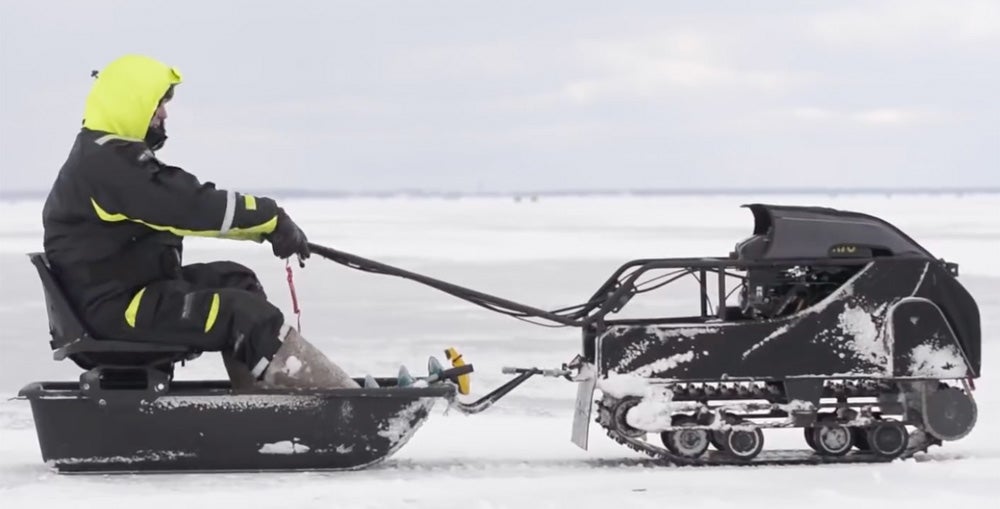
Final Verdict
Category-defining products don’t come along very often, but the SnowDog UTM appears to be one. Though based on designs that have been used for decades, it offers the North American market a unique and budget-conscious tool for traveling in conditions that resist wheeled vehicles. For many, this may be the solution they’ve been looking for. It certainly doesn’t have any competitors here.
For more information, see the detailed and user friendly SnowDog website for additional details and a complete dealer locator.
About the Gear Doctor: Dr. Sean Michael has been designing, abusing and testing outdoor gear since the 1980’s, and began reviewing for Off-Road.com in 2000. Today, he is Professor of Outdoor Product Design & Development at Utah State University, a product consultant, and a frequent Instructor at Overland Expo. Follow his trips and gear @thegeardoctor on Instagram.
